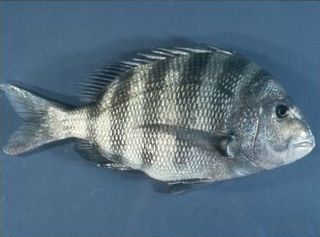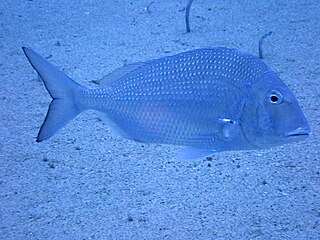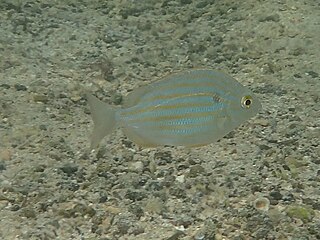
Archosargus probatocephalus, the sheepshead, sheepshead seabream or convict fish, is a species of marine ray-finned fish belonging to the family Sparidae, the seabreams and porgies. This species is found in the Western Atlantic Ocean. The sheepshead is an important species to recreational and commercial fisheries.

Calamus is a genus of marine ray-finned fishes belonging to the family Sparidae, the seabreams and porgies. Most of the species in this genus are found in the Western Atlantic Ocean, with 2 species occurring in the Eastern Pacific Ocean.

Lithognathus is a genus of marine ray-finned fish belonging to the family Sparidae, which includes the seabreams and porgies. Species in this genus are given the common name of steenbras. The genus is found in the Eastern Atlantic Ocean from southwestern Europe to South Africa and into the southwestern Indian Ocean.

Pagrus is a genus of marine ray-finned fishes belonging to the family Sparidae, which includes the seabreams and porgies. These fishes are found in the Western Pacific Ocean, Atlantic Ocean and Mediterranean Sea. They are esteemed food fishes which are targeted by commercial fisheries and are grown in aquaculture.

The sheepshead porgy, also known as the littlemouth porgy or speckled porgy, is a species of marine ray-finned fish belonging to the family Sparidae, the seabreams and porgies. This species is found in the Western Atlantic Ocean.

Lagodon is a monospecific genus of marine ray-finned fish belonging to the family Sparidae, which includes the seabreams and porgies. The only species in the genus is Lagodon rhomboides, the pinfish, red porgy, bream, pin perch, sand perch, butterfish or sailor's choice. This fish is found in the Western Atlantic Ocean and Gulf of Mexico.

Western Atlantic seabream is an ocean-going species of fish in the family, Sparidae. It was first described in 1758 by the "father of modern taxonomy," Carl Linnaeus, in the 10th edition of his book, Systema Naturae. Within their native range, Western Atlantic seabream are also known as the seabream, brim, tropical sheepshead, chopa amarilla, or salema. Although they are eaten, and have been described as pan fish, Western Atlantic seabream have not gained the popularity as a gamefish that their relative, the sheepshead has.

The saddled seabream, also called the saddle bream or oblade, is a species of ray-finned fish belonging to the family Sparidae, which includes the seabreams and porgies. It is the only species in the monospecific genus Oblada. This species is found in the Eastern Atlantic Ocean. It is an important food fish within its range.

Diplodus sargus, the sargo, common white seabream, or white seabream is a species of marine ray-finned fish belonging to the family Sparidae, which includes the seabreams and porgies. This fish is found in the eastern Atlantic Ocean and in the Mediterranean Sea. It is a target species for commercial fisheries and is grown in aquaculture. D. sargussensu lato was formerly thought to be a widespread species in the eastern Atlantic and western Indian Oceans but the taxa outside of D, sargussensu stricto are now recognised as valid species and are part of the D. sargus species complex.

Chrysoblephus gibbiceps, the red stumpnose, red stumpnose seabream or Miss Lucy, is a species of marine ray-finned fish belonging to the family Sparidae, the seabreams and porgies. This fish is endemic to the southwestern Indian Ocean off the coast of South Africa. The International Union for Conservation of Nature classifies this species as Endangered.

Diplodus is a genus of marine ray-finned fish belonging the family Sparidae, which includes the seabreams and porgies. These fishes are found in the Atlantic Ocean, the Mediterranean Sea and the western Indian Ocean.

Acanthopagrus is a genus of marine ray-finned fishes belonging to the family Sparidae, the sea breams and porgies. The fish in this genus are found in the Indian and western Pacific Oceans.

Dentex is a genus of marine ray-finned fishes belonging to the family Sparidae, which includes the seabreams and porgies. The fishes in this genus are found in the eastern Atlantic Ocean and the eastern Indian and Western Pacific Oceans.

Cheimerius is a monospecific genus of marine ray-finned fish belonging to the family Sparidae, the seabreams and porgies. The only species in the genus is Cheimerius nufar, the santer seabream, santer or soldier, of the Indian Ocean.

Diplodus annularis, the annular seabream is a species of marine ray-finned fish belonging to the family Sparidae, the family which includes the seabreams and porgies. This species is found in the Eastern Atlantic Ocean and Mediterranean.

Gymnocrotaphus is a monospecific genus of marine ray-finned fish belonging to the family Sparidae, which includes the seabreams and porgies. The only species in the genus is the Gymnocrotophus curvidens, the Janbruin, an endemic to the coasts of South Africa.

Archosargus pourtalesii, the blackspot porgy or Galápagos seabream, is a species of marine ray-finned fish belonging to the family Sparidae, the seabreams and porgies. This fish is endemic to the Galápagos Islands in the eastern Pacific Ocean.

Evynnis is a genus of marine ray-finned fishes belonging to the family Sparidae, which includes the seabreams and porgies. The genus comprises 4 species, 3 in the Western Pacific Ocean and 1 in the Eastern Atlantic Ocean.

Polyamblyodon is a genus of marin ray-finned fishes belonging to the family Sparidae, which includes the seabreams and porgies. The fishes in this genus are found in the Western Indian Ocean.

Stenotomus is a genus of marine ray-finned fish belonging to the family Sparidae, which includes the seabreams and porgies. The fishes in this genus are found in the western Atlantic Ocean.



















